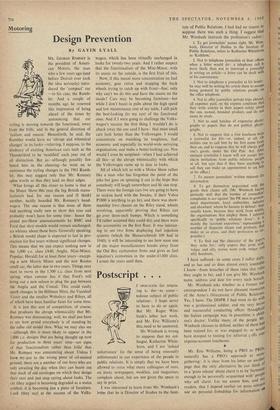Motoring
Design Prevention
By GAVIN LYALL
MR. GEORGE ROMNEY is the president of Ameri- can Motors, the man who a few years ago (and before Detroit ever took the idea seriously) intro- duced the 'compact' car —in his case, the Ramb- ler. And a couple of months ago he renewed 6 this impression of being ahead of the times by announcing that car styling is moving towards the functional, away from the frills, and lb the general direction of 'realism and reason.' Henceforth, he said, the Rambler would have no 'abrupt and whimsical changes' in its looks—referring, I suppose, to the tendency of exciting American cars such as the Thunderbird to be 'modified' each year out of all distinction. But as—although possibly few heard him in the cheering—he went on to announce the styling changes in the 1961 Ramb- ler, this may suggest only that Mr. Romney spins words so that they land on their edges.
What brings all this closer to home is that at the Motor Show this year the big British manu- facturei.s had, for one reason and (I think) another, tacitly boarded Mr. Romney's band- wagen. The one reason is that none of them had anything really new to show this year and probably won't have for some time: hence the proud pre-Show announcements by BMC and Ford that their models would remain unchanged; no whimsy about those boys. Generally speaking, a British model shape is expected to last in pro- duction for five years without significant changes. This means that we can expect nothing new in the 1,000 c.c. class (A40, Anglia, Mini:Minor, Popular, Herald) for at least three years—except- ing a new Morris Minor and the new Rootes small car, the latter due in two years. Things may start to move in the 1,500 c.c. class from next spring, when rumour has it that Ford's will bring out a new saloon to plug the gap between the Anglia and the Consul. This could easily spark changes in the Hillman Minx, the Vauxhall Victor and the smaller Wolseleys and Rileys, all of which have been familiar faces for some time.
It is just this sort of competition, of course, that produces the abrupt whimsicality that Mr. Romney was denouncing; well, we shall just have to see how proud everybody is of standing by the safne old model then. What we may also see —although this is more likely to appear in the 1.000 c.c. designs that are being thought up now for production in three years' time—arc signs of that 'functionalism rather than frills' that Mr. Romney was announcing about. Unless I have my tear to the wrong piece of oil-stained ground, there are a number of our boys who are only awaiting the day when they can heave out that stack of old envelopes on which they design their cars and just stop caring about looks. The car (they argue) is becoming degraded as a status symbol; it is becoming just a piece of furniture. Look (they say) at the success of the Volks- wagen, which has been virtually unchanged in looks for twenty-two years. And I rather suspect that the functionalism of the Mini-Minor, with its seams on the outside, is the first fruit of this.
• Now, if this meant more concentration on fuel economy, gear ratios and stopping the back wheels trying to catch up with front—fine; only why can't we do this and have the seams on the inside? Cars may be becoming furniture—but while I don't boast in pubs about the high speed and low maintenance cost of my table, I still pick the best-looking (to my eye) of the functional ones. And if I were going to challenge the Volks- wagen's success the first thing I wouldn't do is chuck away the one card I have: that most small cars look better than the Volkswagen. I would concentrate on matching 'its toughness, fuel economy and especially its world-wide servicing organisation, and make a better-looking car. Nor would I even be surprised—when I had achieved all this—at the abrupt whimsicality with which the Volkswagen came up to date in looks.
All of which left us with a Motor Show rather like a man who has forgotten the point of the joke but goes on spinning it out in the hope that somebody will laugh somewhere and We can stop. There were the foreign cars (we are going to have to reckon hard with the Swedes, if their Volvo P1800 is anything to go by), and there was show- manship (two chassis on the Riley stand, wheels revolving, apparently proving that Rileys can go over three-inch bumps. Which is something I'd rather assumed they could do), and there were the accessories on the first floor. It was interest- ing to see two firms displaying fuel injection systems (which the Messerschmidt 109 had in 1940); it will be interesting to see how soon one of the major manufacturers breaks away from the Old Boy carburettor firms and gives us fuel injection's economies in the under-£1,000 class.
I count the years until then.














































 Previous page
Previous page